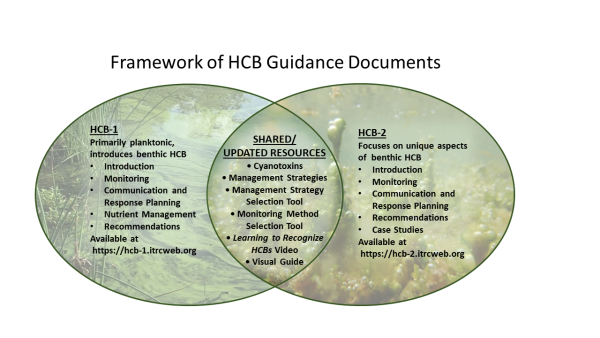
- This event has passed.
Benthic Harmful Cyanobacteria Bloom (HCB-2) Training
April 28, 2022 @ 12:00 pm - 1:00 pm CDT
FreeStrategies for Preventing and Managing Harmful Cyanobacteria Blooms (Two Part Series)
 The Harmful Cyanobacteria Blooms (HCBs) training reviews key information found in the two ITRC HCB Guidance Documents, the 2021 Strategies for Preventing and Managing Harmful Cyanobacterial Blooms (HCB-1) and the 2022 companion document focused on benthic HCBs (HCB-2). ITRC’s HCB-2 focuses on the ecology, toxin production, management, and mitigation of benthic HCBs and is a companion document to the HCB-1 document released by ITRC in March 2021.
The Harmful Cyanobacteria Blooms (HCBs) training reviews key information found in the two ITRC HCB Guidance Documents, the 2021 Strategies for Preventing and Managing Harmful Cyanobacterial Blooms (HCB-1) and the 2022 companion document focused on benthic HCBs (HCB-2). ITRC’s HCB-2 focuses on the ecology, toxin production, management, and mitigation of benthic HCBs and is a companion document to the HCB-1 document released by ITRC in March 2021.
Cyanobacteria are microscopic, photosynthetic organisms that can be found naturally in all aquatic systems. Under certain conditions, cyanobacteria can multiply and become very abundant, discoloring the water throughout a water body or accumulating at the surface. These occurrences are known as “harmful cyanobacterial blooms (HCBs).” HCBs can occur in many parts of a water body. Planktonic HCBs occur when cyanobacteria dominate the open water of water bodies. ITRC’s HCB-1 guidance includes information about planktonic HCBs.
In addition to being suspended in the open water, some cyanobacterial species grow attached to surfaces in a water body. These attached cyanobacteria can grow at the bottom of a water body (benthic zone) but may also be found nearer to the surface growing on submerged vegetation or woody debris. In any of these habitats the benthic cyanobacterial mats can produce and release cyanotoxins into the environment. When cyanobacteria proliferate as attached mats in benthic habitats instead of planktonic blooms, they present unique challenges to evaluating and communicating the public health and environmental risks caused by this less familiar appearance of cyanobacteria.
HCB-1 Training
The Harmful Cyanobacteria Bloom (HCB-1) training provides an overview of cyanobacteria (particularly planktonic blooms) and their management, covering five sections from the ITRC HCB-1 guidance document:
- Introduction to the Cyanobacteria (Section 3)
- Monitoring (Section 4)
- Communication and Response Planning (Section 5)
- Management and Control (Section 6)
- Nutrient Management (Section 7)
HCB-2 Training
The Benthic Harmful Cyanobacteria Bloom (HCB-2) training provides an overview of benthic cyanobacteria and their management, covering five sections from the ITRC HCB-2 guidance document:
- Introduction to the Benthic Cyanobacteria (Section 1)
- Cyanotoxins (Section 2)
- Monitoring for Benthic Cyanobacteria (Section 3)
- Introduction to Treatment Strategies (Section 4)
- Communication and Response Planning for Benthic Cyanobacteria (Section 5)
After both training’s, you should understand:
- The basic ecology and physiology of planktonic and benthic cyanobacteria, and the harmful effects they have on health, the environment, and local economies
- An overview of cyanotoxin classes and available cyanotoxin thresholds for human health (recreational and drinking water) and domestic animals
- Common approaches to monitoring for cyanobacteria and cyanotoxins, and how to build a monitoring program
- The importance of good communication and coordinated response during HCBs, and the elements of a good response plan
- Available options for in-lake management and control of HCBs, including an introduction to possible treatment options for benthic cyanobacteria
- Nutrient management options to reduce the likelihood of HCBs in your water body
We encourage you to use the ITRC HCB Resources (HCB-1 and HCB-2) and the recorded trainings to learn about planktonic and benthic cyanobacteria, monitoring approaches, management of active blooms, and prevention of blooms in the future. For regulators and other government agency staff, these materials present the current state of the science on cyanobacteria and approaches to manage and reduce the occurrence of blooms. We share examples and resources from across the country that can help you develop approaches of your own. While the training makes every effort to keep the information accessible to a wide audience, it is assumed that the participants will have some basic technical understanding of biology, lake management, chemistry, and environmental sciences. As with other emerging concerns, our understanding of HCBs continues to advance. These trainings help you build HCB response plans now and point you to resources that will keep you up to date in the future.

